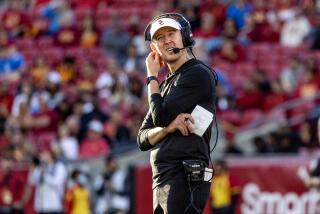Writer fails to unravel the Armstrong enigma
- Share via
Lance Armstrong’s War
One Man’s Battle Against Fate, Fame, Love, Death, Scandal, and a Few Other Rivals on the Road to the Tour de France
Daniel Coyle
HarperCollins: 326 pp., $25.95
*
It’s Tour de France time. Time to look for a book that’ll tell you what makes Lance Armstrong tick.
Keep looking. Daniel Coyle’s new book isn’t the one.
“Lance Armstrong’s War” is a tediously written recap of the cancer survivor’s historic sixth win of the Tour de France in 2004, packaged in a bewildering jumble of dozens of bit players in his life -- teammates, rivals, agents, trainers, etc. -- all in orbit around The Man. Insects, really.
“It’s Not About the Bike,” Armstrong’s 2000 book written with Sally Jenkins, provides far more insight into what fuels the man seeking a seventh victory in the world’s most famous bike race.
The closest Coyle comes to the bull’s-eye is this quote, from onetime Armstrong teammate Floyd Landis: “Lance doesn’t want a hug -- he just wants to kick everyone’s ass.”
Sometimes you see it in the 33-year-old Texan’s raptor-like face, surely the most photogenic in sports. On the bike, as sweat dribbles from his chin, his face snarls, rages and generally evokes the feeling that here is some kind of dangerous psychotic, out for a nice bike ride.
Recently, the Wall Street Journal tried to compare Armstrong’s six consecutive Tour wins with other sports streaks, such as wrestler Aleksandr Karelin’s 13-year win record. Or heavyweight champion Joe Louis’ 25 straight defenses of his title. Or Sonja Henie’s 10 successive world figure skating championships.
Preposterous.
Not one of those remotely compares to winning even two Tours. People, we’re talking about a three-week, 2,200-mile bike race.
Dare we say it? The greatest athlete in U.S. history? That wouldn’t be difficult if not for, well, those pesky drug rumors.
Coyle presents persuasive reasons why the speculation that Armstrong uses performance-enhancing drugs is false. The cyclist, Coyle writes, has been tested 30 to 40 times a year and has never flunked. And Armstrong’s agent writes clauses into endorsement contracts stating the contracts would be voided if Armstrong ever tested positive.
Of course, there are masking agents.
Then there’s this school of thought: If the critics of pro cycling are correct, that “everybody” in cycling uses drugs (and masking agents), then that’s a level playing field, right? If so, then six consecutive Tour wins is nothing short of amazing, with or without drugs.
An Armstrong insider, on the drugs question, put it to Coyle this way: “Think about it for a sec. We’re building long-lasting relationships with people who are spending a lot of money -- Coke, Nike, Subaru ... if we’re ... lying, we can kiss it all goodbye. Does anybody think for a second a secret this big wouldn’t come out?”
The book touches on Armstrong’s testy relationship with another American Tour winner, Greg LeMond. On the subject of drugs, LeMond told Coyle: “The problem with Lance is, if you raise the doping question, you’re either a liar or you’re out to destroy cycling.”
Coyle also touches on Armstrong’s acute sensitivity to what’s written about him. When an article about him is posted on the Web, his Blackberry chirps. Those who write Armstrong articles on the Web aren’t surprised to receive an e-mail response from Armstrong, sometimes within minutes of its posting.
Then there’s Armstrong’s money. Coyle reports that Armstrong’s 2004 endorsement income was $19 million. Sports Illustrated recently published its annual list of America’s highest-paid athletes and ranked Armstrong 28th, with $497,500 in race winnings and $17.5 million worth of endorsements.
The book says that Armstrong’s 2004 divorce from wife Kristin cost him $15 million. The cyclist’s girlfriend, rock singer Sheryl Crow, whom Armstrong calls “Juanita Cuervo,” flits in and out of the book. Coyle reports that Crow has unusually muscular calves, and that her gift to Armstrong for winning the 2004 Tour was a 1970 black Pontiac GTO.
Finally, though, Coyle offers a clue as to how Armstrong cycles at a level so far above his rivals. When pushed in stress tests into the red zone, he writes, Armstrong’s body processes lactic acid at least twice as efficiently as other cyclists.
Biochemical fluke? Genetic fluke?
Whatever, that’s Lance. One of a kind
*
Earl Gustkey, a former Los Angeles Times sportswriter, lives in Bozeman, Mont.
More to Read
Sign up for our Book Club newsletter
Get the latest news, events and more from the Los Angeles Times Book Club, and help us get L.A. reading and talking.
You may occasionally receive promotional content from the Los Angeles Times.







